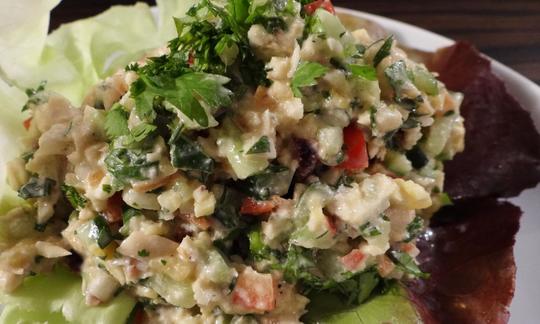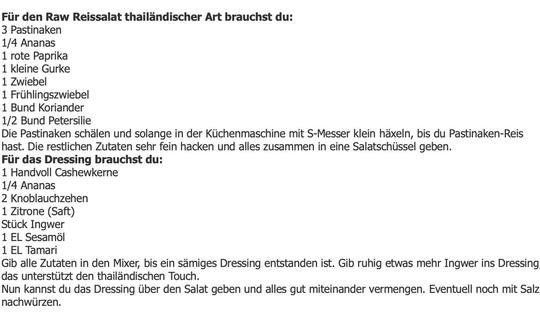Thai-style rice salad with parsnip, pineapple, ginger
vegan
Ingredients (for servings, )
| For the rice salad | |
|---|---|
| 3 | Parsnips, raw (organic?) (13 oz) |
| ¼ | Pineapple, raw (organic?) (8.0 oz) |
| 1 | Onions, raw (organic?) (3.9 oz) |
| 1 | Sweet peppers, red, raw (organic?) (5.8 oz) |
| 1 small | Cucumbers, raw (organic?) (8.3 oz) |
| 1 | Spring onions, stems and leaves only (raw, organic?) (0.87 oz) |
| 1 bunch | Coriander leaves, raw (0.70 oz) |
| ½ bunch | Parsley, fresh, raw (leaf parsley, parsley) (0.53 oz) |
| For the dressing | |
| ¼ | Pineapple, raw (organic?) (8.0 oz) |
| 2 cloves | Garlic (organic?) (0.21 oz) |
| 2 cm | Ginger, raw (organic?) (0.76 oz) |
| 1 | Lemons, raw (limes, organic?) (2.0 oz) |
| ½ cup | Cashew nuts, raw? organic? (cashew nuts) (2.3 oz) |
| 1 tbsp | Sesame oil, raw? organic? (0.48 oz) |
| 1 tbsp | Soy sauce (tamari, organic? raw?) (0.63 oz) |
Equipment
- food processor
- grater
- vegetable peeler
Type of preparation
- chop or grind
- food preparation without heating
- blend
- remove the skin
- peel
- grate (shred)
Preparation
For the rice salad
Peel the parsnips and chop them in the food processor with the S-blade until you get parsnip rice.Peel the pineapple and onion and wash the remaining vegetables. Chop all ingredients very finely and put them in a salad bowl together with the chopped parsnips.
You can also finely grate the cucumber using a kitchen grater.
For the dressing
Peel the pineapple, peel the garlic, chop the ginger, squeeze the lemon and use only the juice. Put all the ingredients in the blender and mix until you have a creamy dressing.The original recipe calls for one piece of ginger for 3 servings. For the cashews, use a handful. This is roughly equivalent to ½ cup.
Tip from Yvonne Zindler : Add a little more ginger to the dressing, it will enhance the Thai touch.
Finishing the salad
Pour the dressing over the salad and mix everything together well. Season with salt if necessary and serve.
|
Nutritional Information per person
Convert per 100g
|
2000 kcal | |
|---|---|---|
| Energy | 396 kcal | 19.8% |
| Fat/Lipids | 15 g | 21.6% |
| Saturated Fats | 2.5 g | 12.5% |
| Carbohydrates (inc.dietary fiber) | 64 g | 23.5% |
| Sugars | 28 g | 31.6% |
| Fiber | 12 g | 49.6% |
| Protein/Albumin | 9.2 g | 18.4% |
| Cooking Salt (Na:365.8 mg) | 929 mg | 38.7% |
| Essential micronutrients with the highest proportions | per person | 2000 kcal | |
|---|---|---|---|
| Vit | Vitamin C (ascorbic acid) | 189 mg | 236.0% |
| Vit | Vitamin K | 109 µg | 146.0% |
| Min | Manganese, Mn | 2.8 mg | 138.0% |
| Min | Copper, Cu | 0.91 mg | 91.0% |
| Vit | Vitamin B9, B11 (Folate, as the active form of folic acid) | 172 µg | 86.0% |
| Elem | Potassium, K | 1'213 mg | 61.0% |
| Vit | Vitamin B6 (pyridoxine) | 0.69 mg | 49.0% |
| Sodium, Na | 366 mg | 46.0% | |
| Elem | Phosphorus, P | 298 mg | 43.0% |
| Prot | Tryptophan (Trp, W) | 0.10 g | 41.0% |
Detailed Nutritional Information per Person for this Recipe
The majority of the nutritional information comes from the USDA (US Department of Agriculture). This means that the information for natural products is often incomplete or only given within broader categories, whereas in most cases products made from these have more complete information displayed.
If we take flaxseed, for example, the important essential amino acid ALA (omega-3) is only included in an overarching category whereas for flaxseed oil ALA is listed specifically. In time, we will be able to change this, but it will require a lot of work. An “i” appears behind ingredients that have been adjusted and an explanation appears when you hover over this symbol.
For Erb Muesli, the original calculations resulted in 48 % of the daily requirement of ALA — but with the correction, we see that the muesli actually covers >100 % of the necessary recommendation for the omega-3 fatty acid ALA. Our goal is to eventually be able to compare the nutritional value of our recipes with those that are used in conventional western lifestyles.
| Essential fatty acids | per person | 2000 kcal |
|---|---|---|
| Linoleic acid; LA; 18:2 omega-6 | 3.7 g | 37.0% |
| Alpha-Linolenic acid; ALA; 18:3 omega-3 | 0.09 g | 4.0% |
| Essential amino acids | per person | 2000 kcal |
|---|---|---|
| Tryptophan (Trp, W) | 0.10 g | 41.0% |
| Threonine (Thr, T, irreversibly transaminated) | 0.26 g | 28.0% |
| Valin (Val, V) | 0.37 g | 23.0% |
| Isoleucine (Ile, I) | 0.28 g | 22.0% |
| Phenylalanine (Phe, F) | 0.34 g | 22.0% |
| Leucine (Leu, L) | 0.47 g | 20.0% |
| Lysine (Lys, K, irreversibly transaminated) | 0.36 g | 19.0% |
| Methionine (Met, M) | 0.12 g | 13.0% |
| Vitamins | per person | 2000 kcal |
|---|---|---|
| Vitamin C (ascorbic acid) | 189 mg | 236.0% |
| Vitamin K | 109 µg | 146.0% |
| Vitamin B9, B11 (Folate, as the active form of folic acid) | 172 µg | 86.0% |
| Vitamin B6 (pyridoxine) | 0.69 mg | 49.0% |
| Vitamin B1 (Thiamine) | 0.42 mg | 38.0% |
| Vitamin B5 (Pantothenic acid) | 1.8 mg | 31.0% |
| Vitamin E, as a-TEs | 3.3 mg | 28.0% |
| Vitamin B3 (Niacin) | 3.0 mg | 19.0% |
| Vitamin A, as RAE | 155 µg | 19.0% |
| Vitamin B2 (Riboflavin) | 0.24 mg | 17.0% |
| Vitamin B7 (Biotin, ex vitamin H) | 5.7 µg | 11.0% |
| Essential macroelements (macronutrients) | per person | 2000 kcal |
|---|---|---|
| Potassium, K | 1'213 mg | 61.0% |
| Sodium, Na | 366 mg | 46.0% |
| Phosphorus, P | 298 mg | 43.0% |
| Magnesium, Mg | 151 mg | 40.0% |
| Calcium, Ca | 124 mg | 16.0% |
| Essential trace elements (micronutrients) | per person | 2000 kcal |
|---|---|---|
| Manganese, Mn | 2.8 mg | 138.0% |
| Copper, Cu | 0.91 mg | 91.0% |
| Iron, Fe | 4.0 mg | 28.0% |
| Zinc, Zn | 2.7 mg | 27.0% |
| Selenium, Se | 7.8 µg | 14.0% |
| Iod, I (Jod, J) | 3.1 µg | 2.0% |
| Fluorine, F | 2.4 µg | < 0.1% |
The Thai-style rice salad with parsnip, pineapple and ginger looks very similar to a regular rice salad.
Vegan cooked food instead of raw food: Since both cashew nuts and soy sauce are used, we have declared this recipe as "Vegan cooked food" (see "Tips" for strict raw food).
Portion size: This dish is suitable as a starter or main course, depending on the portion size. We have set the size for a main course at 3 portions.
Nutrient profile: According to GDA guidelines, one portion covers more than twice the average daily requirement of vitamin C and over 100% of that of manganese and vitamin K. Copper and folic acid are almost completely covered. However, the ratio of omega-6 to omega-3 fatty acids is 44:1, which is significantly above the recommended range. The salt content is quite high at almost 40% of the daily requirement.
Parsnips: The roots, which are mainly harvested in winter, have a sweet and spicy taste, sometimes even bitter. They taste like carrots and celery and are also similar to parsley root, but milder. Parsnips not only stimulate the appetite, but also have a diuretic effect. Compared to carrots, parsnips contain a much higher content of fiber, potassium, protein and vitamin C.
Pineapple : Ripe pineapple has a fruity, sweet taste with a slightly sour note and is very juicy. Pineapple is also rich in vitamins (especially vitamin C) and contains a variety of minerals and enzymes, such as the protein-splitting enzyme bromelain.
Ginger: Ginger is aromatic and has a sharp, spicy taste that is due to the pungent compound gingerol, a substance with anti-carcinogenic and anti-inflammatory properties. As a cooking ingredient, ginger root is used in various forms, including fresh, dried and ground.
Cashew nuts: Hardly any other food contains as high a proportion of the essential amino acid tryptophan as cashew nuts. Tryptophan is an essential nutrient in the production of the neurotransmitter serotonin. Cashews, also called cashew nuts or simply cashews, are a good source of minerals such as magnesium and iron. However, the ratio of omega-6 to omega-3 fatty acids is very poor at 48:1.
Coriander: Opinions vary widely regarding the taste of coriander. Some people react to its intense, slightly soapy aroma with aversion or even nausea. According to statistics in Switzerland, 15% of all allergy sufferers are sensitive to coriander. In these cases, simply leave this ingredient out. However, it is precisely the coriander ingredient that gives the dish its exotic note. There is no alternative with a similar taste. Flat-leaf parsley, which looks similar, has a completely different taste.
Yvonne Zindler on ginger: Feel free to add a little more ginger to the dressing, it will enhance the Thai touch.
Strictly speaking, no raw food:
- Cashews: Cashew nuts or cashew kernels have practically always been heated, even if the packaging says "raw cashew kernels", which usually only indicates that the toxic cardol was deactivated using steam rather than a roasting process. We can only assume that the product is raw if the process is explained in detail and checked. You can find more information about this under the relevant ingredient.
- Soy sauce: During the manufacturing process, the soybeans are heated because green beans of all kinds contain the glycoprotein phasin, which is toxic to humans. Heating processes (cooking, roasting, etc.) destroy phasin and thus make soybeans and products made from them, such as soy sauce, tofu, miso or tempeh, edible for humans. This means that even unpasteurized soy products are no longer actually raw food, but merely cooked food that has been "revived" through fermentation.
Health: For health reasons, we have created an alternative recipe with variations in the ingredients. Please read the link behind this motivation: Vegans often eat unhealthily. Avoidable nutritional errors.





